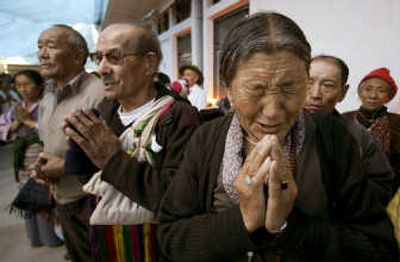China allows reporters back into Tibet capital

LHASA, China – A group of Tibetan monks disrupted a tour by foreign reporters to Lhasa today, complaining that there is no religious freedom and that the Dalai Lama is not to blame for recent violence.
About 30 monks surged into a carefully stage-managed visit to the sacred Jokang Temple in Lhasa by foreign reporters. They yelled, “Tibet is not free! Tibet is not free!”
They also said their spiritual leader, the Dalai Lama, had nothing to do with recent anti-government riots by Tibetans in Lhasa, where buildings were torched and ethnic Han Chinese were attacked. Government handlers tried to pull the journalists away when the monks protested.
The government has said the March 14 riots were supported by “the Dalai clique.”
With the exception of Thursday’s disruption, the first group of foreign journalists allowed into the Tibetan capital since soon after the riots has been given a carefully monitored glimpse of a city divided.
On Wednesday, the first day of the visit, police presence was visible but not overbearing in the newly built up and heavily Chinese portions of Lhasa, teams of security forces stood in the lanes near the Jokhang Temple.
Two Tibetan teachers drinking in a nearby bar said they were enjoying a first night out after nighttime curfews kept them at home eating mainly tsampa – roasted barley – since the day after the March 14 riot. One reason the curfew was loosened, they said, was the foreign media visit.
An acrid odor hung in the blocks near the old city where rows of burned out buildings stand as evidence of the violence. Many shops were closed, some from a lack of business, others from looting that left their migrant Chinese owners with little to sell.
China rarely allows foreign reporters into Tibet under normal circumstances, so the media tour underscores the communist leadership’s determination to contain any damage ahead of the Beijing Olympics in August that was supposed to celebrate China as a modern, rising power.
Asked to comment on the reporters’ trip, the Dalai Lama – the exiled spiritual leader of Tibetans – called it a “first step.” He said he hoped the trip would take place “with complete freedom.”
The rioting and four days of protests that preceded it were the worst anti-Chinese demonstrations in Lhasa in nearly two decades, and they sparked protests in Tibetan areas across a vast portion of western China. The government says at least 22 people have died in Lhasa, most of them “innocents” killed by rioters, while exiled Tibetan rights groups say 140 Tibetans have died in the crackdown across western China.
Chinese state media and officials said Wednesday that more than 660 protesters have surrendered in Lhasa and in Sichuan province, site of at least two violent confrontations between police and Tibetan protesters.
The Chinese government has maintained its response was measured and comparable to what any responsible government would do when faced with civil unrest.
That message underlined much of the official program put on for the roughly two dozen American, European, Middle Eastern and Asian reporters from the Wall Street Journal, USA Today, the Financial Times, Japan’s Kyodo News Agency, KBS of South Korea and Arab broadcaster Al-Jazeera.
“The situation in Lhasa is returning to normal,” Liu Xuan of the Tibetan Information Office told the reporters. The Potala – the Dalai Lama’s former palace and a tourist attraction – was reopened Wednesday for the first time since the violence.
But while police in the Tibetan old city checked ID papers at twilight, letting only residents into the narrow alleys, by 10 p.m. the area seemed deserted except for the police. Patrols of a dozen police with helmets and shields marched on the streets.